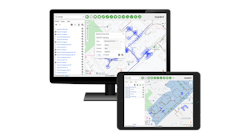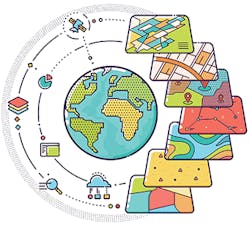You Need A GIS Life Preserver
When decisions need to be made, the importance of having quality data cannot be understated. However, quality data alone may not be enough. In an environment where the abundance of data becomes overwhelming, there needs to be a way to obtain the information that can intelligently inform your decisions.
Using quality and readily available data in conjunction with Geographic Information System (GIS) analytics can help uncover new opportunities and assist in planning and building out infrastructure with greater efficiency. This provides visibility into the population in a given service area, what is needed, and what it takes to get it to them.
By creating custom-tailored, purpose-built maps to develop reliable and accurate assessments, GIS analytics presents the relevant, fact-based information you need in an easily digestible format, allowing you to discard the frequently unreliable cookie- cutter estimates that get in the way of good decision-making.
This article reviews the availability of data, its sources, and the benefits that can be derived by converting it into detailed geographic representations that enable forward-looking companies to visualize, discover, and accurately evaluate, new opportunities. Then, convert those opportunities into working projects that deliver revenue.
Data Overload = Swimming With Sharks
Understanding the geographic areas to which you have access is essential for locating new opportunities and developing effective strategies for imminent builds as well as for future projects. Drilling down into the granular details required to advance a project with confidence frequently requires collecting and managing large amounts of data. Historically, this has involved the time-consuming and cost-intensive tasks of gathering physical data, and working out the details with a pen and pencil or a complex spreadsheet.
Today, much of this data is available digitally, often for free or at a very low cost from public sources, such as city, state, county, and federal, offices. Grant studies and 911 databases at the state or county level can also supply enormous amounts of information.
A vast amount of usable data is available but it never gets effectively utilized.
Over the last 5 years, the increase in available data has been phenomenal. The primary challenges arise in locating and accessing the data that’s needed — and the managing and parsing of the data without being overwhelmed by it. Learning to key in on the right information and to scale it to a size that’s both manageable and useful is essential, and has been a stumbling block for many.
Keep The Horizon In View
GIS is a system that connects geospatial data to a map, integrating location data with descriptive information. In short, it can take enormous amounts of data to create clear and understandable custom maps that allow for the visualization of opportunities that exist and choices that are available in a selected region.
And the visual component is crucial, as it reveals patterns, relationships, and geographic context, clearly; it turns georeferenced data sets into visualized databases that allow you to focus instantly on what can and cannot be done. This information can be presented in a way that is understandable and digestible, even to board members who may not be well-versed in the significance of what the detailed data represents.
For example, GIS can be used to create easy-to-read custom color-coded maps that plainly indicate county lines overlaid by grids that illustrate areas already served by existing fiber. For instance, superimposed over that map, areas that were won in competing RDOF auctions can be shown, along with road maps that help assess route miles that need to be built, with address points that exist within the area. Additional information can be included, such as territory marked for endangered species and wetlands, that may affect planning decisions. The details and data are granular, but they can be composed quickly, layer by layer, into a robust visual map that reveals, at a quick glance, information that could take days or weeks to tease out from the raw data alone.
With today’s mapping resources and analytics, a shovel-ready budget can be prepared in a fraction of the time it used to take. GIS allows a company to proactively study a specific area at a fairly low cost, and to have that information with a budget already worked out and in their pocket before a program is even announced. It can turn what might have been an unworkable task of gathering enough information to make a meaningful submission to a grant authority into a cost-effective study for a particular area that is ready in advance when the opportunity arises.
A few hours of preparation and analysis of data from readily available sources can yield enough information to make a solid cost estimate, in many cases. In fact, creating area maps by simply using the tools that are currently available can represent substantial time savings over attempting to manage the data manually. Clearly, this can result in substantial savings in terms of traditional investigation costs.
No S.O.S. Calls
For counties and municipalities looking to foster broadband programs, GIS mapping can be performed when assessing feasibility, taking guesswork out of financial estimates and helping to assign a hard number to projected costs. With these numbers in place, it becomes possible to work backwards to determine how much assistance is needed to build out a project, while providing enough detail to encourage telcos and electric co-ops to engage.
Models can be created for areas that are not currently shovel-ready, and assign reliable cost values to them. This is important so when an opportunity for funding becomes available, GIS research can be submitted to the applicable grant agency, and these models can be considered sufficient to qualify as shovel-ready.
It’s now possible to determine a number of critical factors that could affect the cost of construction without ever needing to put feet on the ground, while being far more accurate than competing methods would allow. Uncertainties that can delay a project or lead to cost overruns are reduced by having key information earlier in the development process, such as how much aerial vs. buried fiber is required, how many poles need to be touched, or how many poles are at risk.
And the value of this work is not lost once funding has been received or the construction phase has been entered. For instance, preliminary orders for fiber can be based on the data that’s been collected and the maps that have been created. As projects and developments grow and change over time, the maps are easily updated to assist in future project development.
Finally, the data collected and managed through GIS analytics becomes a living document. If a project has been put on hold for an extended period of time, nothing is lost; the information and maps can be updated quickly — usually in a matter of minutes, rather than days, as new data is simply integrated into the existing structure.
Timelines on many projects are incredibly short, and the need to move fast is essential. Intelligent GIS mapping offers the ability to identify and act on opportunities quickly. Additional benefits that arise from bringing GIS mapping into the picture affect planning, budgeting, efficiency, and reporting, and can also lead to improved management and decision-making.
The efficiency and reliability of this low-cost option, especially when compared to gathering data and parsing it manually, helps with making educated choices that are critical for broadband and telecommunications solutions.
For more information, please email [email protected] or visit https://finleyusa.com/.
Christopher’s LI: https://www.linkedin.com/in/christopher-konechne-27a905132.
Company Social Media Handles:
Twitter: https://twitter.com/FinleyEng
LI: https://www.linkedin.com/company/finleyusa
FB: https://www.facebook.com/FinleyEngineeringCompanyInc






